Editor’s note: For full disclosure, Jeff Thompson is a contributor to Sightline Institute. (Of course, many people concerned about sustainable cities in the Northwest contribute to Sightline.)That fact did not influence this article.
Seattle’s Interbay industrial district is a landscape dominated by warehouses, small manufacturing plants, and parking lots, with hardly a sidewalk to be found. Unlike other former manufacturing districts in Cascadia’s first city, like Amazon-occupied South Lake Union, Interbay has very few buildings that would qualify as “mixed-use,” and that’s by design; for decades, the district, like Seattle’s other industrial areas, has been “preserved” by zoning that prohibits most non-industrial uses, including office space, large retail stores, and housing.
In recent years, though, the city’s housing shortage has led developers to take a new look at the city’s previously sacrosanct industrial areas and ask: Why couldn’t people live here? Jeff Thompson, president of the Freehold Group, owns several properties in the area. A couple of years ago, he did some back-of-the-envelope math and discovered that by taking just five percent of the city’s vacant industrial land—about 28 acres—and rezoning it to allow six-story buildings, the city could accommodate 6,800 new apartments, without touching Seattle’s famously development-averse single-family neighborhoods. It’s a possibility relevant not only in Seattle but across Cascadia and beyond, everywhere housing shortages are escalating rents and pinching off opportunity for urbanites.
“Most of our industrial areas are derelict—full of potholes, with streets that were never meant to be places for people,” Thompson says.
Developers could improve those areas, adding sidewalks and paving crumbling streets themselves at a lower cost (and a lower lifespan) than expensive, heavy-duty reinforced concrete pavement typically found in industrial areas. In exchange, they would be allowed to build housing for some of the thousands of people who continue to pour in to Seattle every year—more than 100,000 of them between 2010 and 2017 alone.
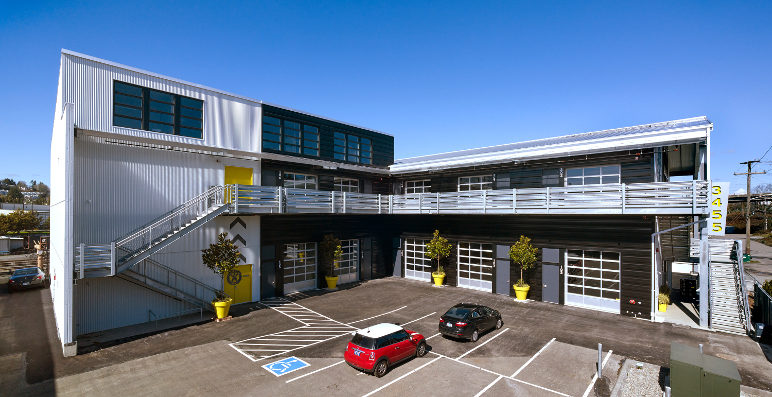
Completed in 2017, the Freehold Group’s R&D Building in Seattle’s Interbay district provides small-scale flexible spaces for evolving industrial needs. Design Architect: Schemata Workshop, Photographer: Chris Eden, used with permission.
Yes, those new residents might find themselves living next to warehouses where trucks go in and out day and night. Yes, they may have to get used to the sound of railroad traffic. But how is that different, Thompson asks, than living in the middle of any big city?
“You can go to Brooklyn or Chicago and find an apartment next to an elevated rail line,” Thompson says. “Is it inhumane of us to provide housing like that?”
Housing can be compatible with industrial areas
Like Seattle’s evolution from sleepy outpost to big city, the definition of “industrial” has been quietly changing for at least the past several decades. Instead of factories spewing toxic fumes and “enormous vats of splashing and spluttering metal,” Thompson says, the term now encompasses firms that make software that enables customers to make their own robots at home, or labs where food production companies test new products. Or companies like Interbay’s Thermetrics, which makes mannequins that measure how fast an air conditioner cools down a car, or how effectively a sleeping bag retains a person’s body heat.
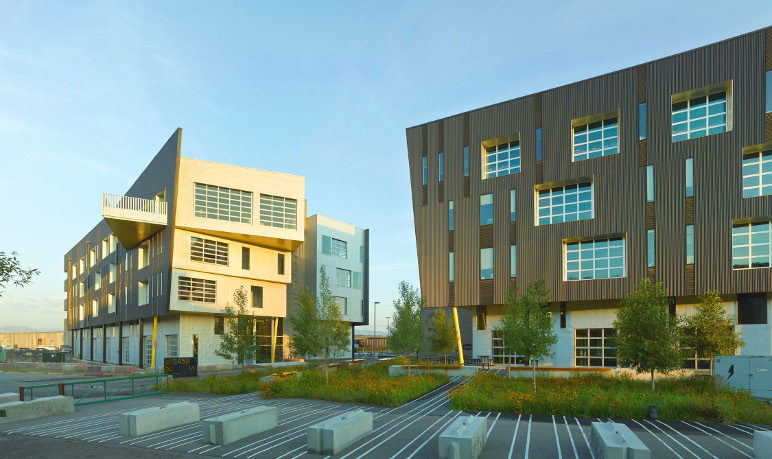
Part of the TAXI development in Denver’s RiNo neighborhood. Design Architect: Dynia Architects Photographer: Tim Hursley, used with permission.
The idea that people might choose to live in an industrial area is no longer revolutionary. At the TAXI development in Denver’s River North industrial area, a company that manufactures boots for snowboards sits cheek to jowl with an outpost of the international advertising firm Saatchi and Saatchi. The firm is just downstairs from 48 units of housing, which overlook a pool built from recycled shipping containers that offers a view of an active railroad line. Also on site: Business incubators, a pot shop, design and architecture studios, and several software firms. Several nearby developments follow a similar mixed industrial-housing model, and developers have proposed hundreds of units of affordable housing as part of a future project in the area.
The success of the TAXI project, Thompson says, proves that industrial areas are compatible with housing. “It’s an industrial area, and it is a popular, cool place to be,” Thompson says. “People may say, ‘No one will want to live [in an industrial area]—well, they do want to live there.”
According to Dave Gering, executive director of the Manufacturing Industrial Council, between 75 and 80 percent of Seattle’s industrial land is still in heavy industrial use, and there are still about 106,000 industrial jobs in the city. Even now, vacancy rates are low—in the Puget Sound region, the industrial vacancy rate is around 3 percent, (1.6 percent in Seattle proper), which is significantly less than the national vacancy rate of 5 percent.
“The railroad is still there,” Gering says. “Boeing’s 747 production is twice what it was 10 years ago. Maritime is almost as big as it ever was.”
Historically, the city has sided with Gering. In 2007, the Seattle City Council adopted legislation that expanded restrictions on industrial land use and clamped down on retail and commercial uses in industrial areas. (The council did allow two-story industrial buildings, a slight concession to the changing definition of “industrial” use). Almost 10 years later, in 2016, then-mayor Ed Murray convened a task force made up of business, political, and labor leaders to provide recommendations for a new industrial lands policy to accompany Seattle 2035, the latest update to the city’s comprehensive land-use plan.
The Industrial Lands Advisory Council—headed by Gering and land-use attorney Jack McCullough, who did not return calls for comment—was supposed to come back to the mayor with recommendations by early 2017. Although the group has not yet released any formal recommendations, Seattle Office of Planning and Community development senior planner Tom Hauger did give a presentation to the Seattle Planning Commission last month. This was part of a prelude to the release of a “draft concept” plan for the city’s industrial areas that could open much of the industrial land in the SoDo district—around the stadiums and within walking distance of the two south-of-downtown light rail stations—to office uses.
This could help reduce the traffic impact of the nearly two million new workers that are expected to move to the region by 2050, and it could provide a bridge to the kind of hybrid office/industrial spaces that already exist in Portland.
The proposal, known as the “SoDo concept,” would allow developers to build office space in the district if they provide space for industrial businesses on the lower levels, up to a floor-area ratio (FAR) of 1.0 (imagine roughly as a single story stretching across 100 percent of a lot, two stories that cover half the lot, and so on). In exchange, developers could build up to five times as many stories of office space, up to the height limit, although Hauger said the task force would probably end up settling on two to four additional office stories for each full story of industrial space. That may seem anticlimactic compared to Thompson’s vision of housing-over-office-over-flexible workspaces, but it could mark an important shift in the city’s thinking about the appropriate use for industrial areas in the 21st-century economy.
Hauger told Sightline that the goal would be to accommodate some uses that are barred under current zoning, like Thompson’s hypothetical robot design studio, without increasing land values so much that traditional manufacturing and industrial businesses get pushed out in favor of office space for high-tech companies like Amazon looking for cheap land.
“I think a couple of [task force] members have brought up the idea of housing, but the rest of them said, ‘Let’s not even open that door,’” Hauger says. But the door is already cracked, and even Hauger acknowledges that the city may have to reconsider what to allow in industrial areas in the future. “We may parse out some of those uses differently and decide that some of them could be more compatible with residential uses, but we haven’t gotten to that point yet,” he says.
How Portland figured it out
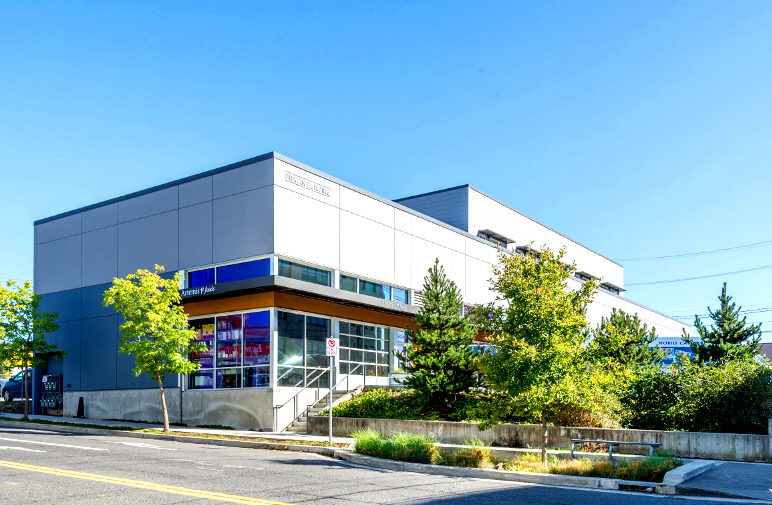
The 2013 Pitman Building in Portland’s Central Eastside neighborhood combines commercial kitchens with office space on the second floor. Building design and photo by Deca Architecture, used with permission.
One Cascadian city did achieve compatibility far sooner than Seattle: Portland. It’s a city with its own inner-city industrial area, its own housing crunch, and its own fraught debate over the future of industrial lands. Like Seattle, Portland has fiercely protected its industrial areas, creating an “industrial sanctuary” zoning category in 1988 to denote areas where industrial uses are sacrosanct. Like Seattle, Portland has struggled with how to define “industrial” uses—settling, ultimately, on a compromise that preserves some areas strictly for traditional industrial purposes while loosening the definition of “industrial.”
But unlike Seattle, Portland allows housing along the main streets that run through the industrial area; of the 630-acre Central Eastside, about 130 acres are zoned for housing. (Housing and standalone retail storefronts are still prohibited or strictly regulated in the rest of the district.) At the same time, through a rezoning effort known as the Southeast Quadrant Project, the city has expanded its Employment Opportunity Subarea to include the entire Central Eastside industrial area. The Employment Opportunity Subarea is a zone that allows so-called “industrial office” uses, flexible space that can accommodate lots of different kinds of businesses.
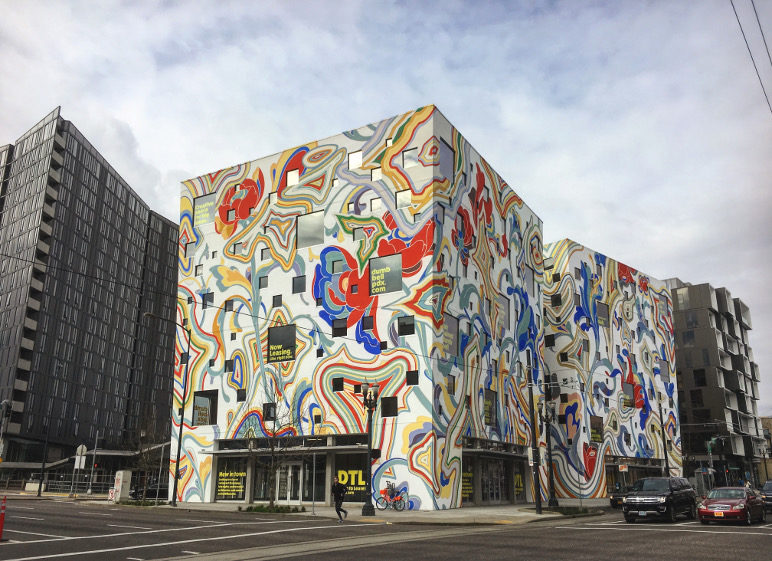
Recently completed developments on arterial streets in Portland’s Central Eastside, from left to right: the Yard apartments, the Fair-haired Dumbbell office building, and Slate apartments. Photo by Dan Bertolet, used with permission.
The difference is palpable. With a few thousand people living in the heart of the industrial area in buildings with names like bside6, the Goat Blocks, and East 12th Lofts, the streets feel more vibrant—more like a revitalized postindustrial downtown than an abandoned warehouse district. With breweries, coffee roasters, and food production labs have come storefronts offering the chance to sit down and grab a beer, a cup of coffee, or a Pacific snapper sandwich. When you walk around the neighborhood, it isn’t that you aren’t aware you’re in an industrial district—thanks to its relatively rigid zoning, the Central Eastside will never be mistaken for Portland’s chichi Pearl District—it’s that the streets still manage to feel like places for people.
“When we started the Southeast Quadrant project, there were only 960 existing units in that district,” says Troy Doss, a senior planner with the city of Portland’s Bureau of Planning and Sustainability. “Since then, over 2,000 have been developed or proposed, and they’re all still being done on available mixed-use sites”—the kind of sites that simply don’t exist inside industrial districts in Seattle.
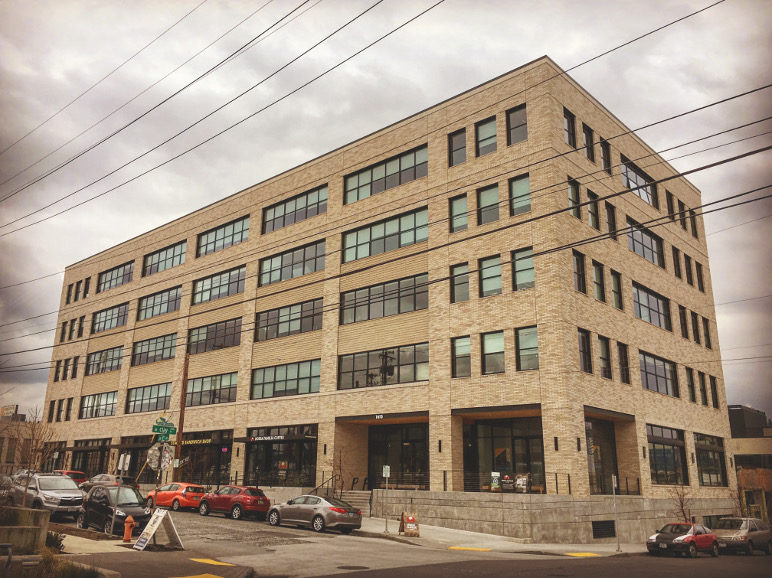
The 2016 Clay Creative building in Portland’s Central Eastside provides flexible office space. Photo by Dan Bertolet, used with permission.
Brad Malsin, the owner of Beam Development, which has redeveloped more than a half-dozen buildings on the Central Eastside, says there’s no reason that housing can’t be compatible with industrial uses. The important thing, he says, is to make sure that whoever leases property in the district knows what they’re getting into. “There’s people who come here and say, ‘I love the buildings, I love the vibe, I love the restaurants, but I can’t stand the [freight] trains” that run through the district. “Well, you don’t belong here.” I ask Malsin: Do people move in and then complain about the noise, as Hauger worries they will do in Seattle? Right on cue, a train goes by, and Malsin pauses before responding.
“To be honest with you,” Malsin says, “the adjacency between residential and a creative industrial sanctuary is very compatible. We don’t get a lot of complaints.”
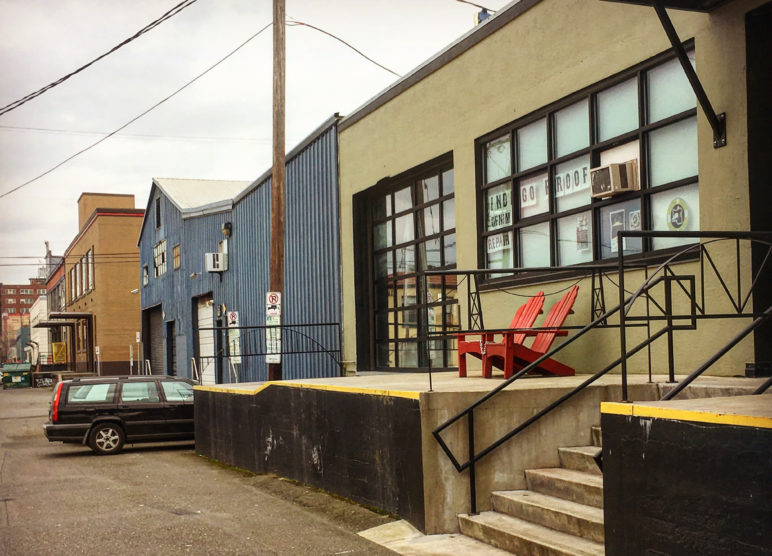
In Portland’s Central Eastside, a warehouse repurposed for the Indigo Proof denim repair shop. Photo by Dan Bertolet, used with permission.
With industrial vacancies at historic lows, housing in traditional industrial areas may be a hard sell. But as technology advances and traditional manufacturing techniques become obsolete, the shift in what counts as “industrial” is only going to accelerate—and with it, the demand for centrally located and transit-accessible housing for the industrial workforce of the future. Seattle and other Cascadian cities could choose to stay the course in an effort to preserve traditional manufacturing—or it could experiment, as Denver and Portland have done, and see how it goes. To Thompson, the choice is clear. “We need to get real about accepting the change that’s coming and make peace with it,” he says—not “get stuck in all these silly conversations about protecting something that is going away.”

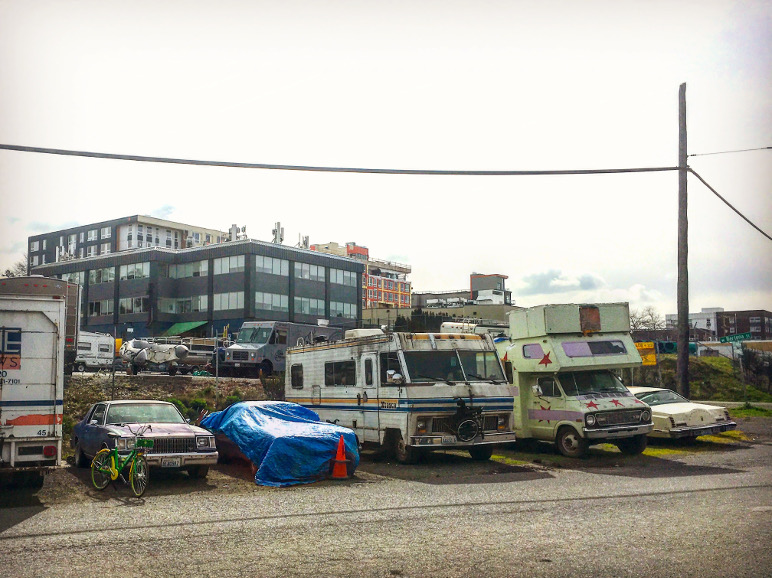
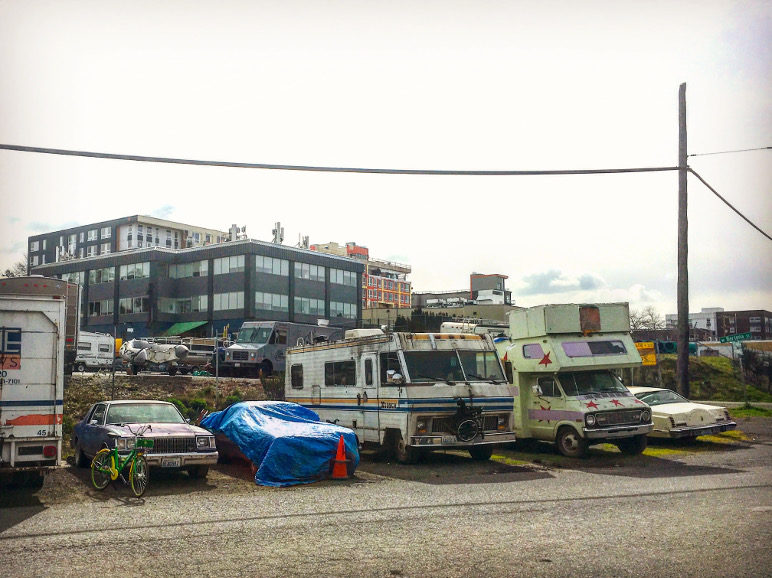








Al Johnson
Residential development near through-routes for “bomb trains” (Sightline’s term) creates health, safety, and environmental justice issues that go well beyond noise. Cities have such limited authority over rail traffic and its hazards that the only way for them to protect their citizens may be zoning that locates housing away from the hazard. Any change in land use policies or designations that enables residential development should be required to address this issue directly.
Michael H. Wilson
This was going to be brought up at a city council meeting tonight in Olympia, but the room chosen for the meeting was to small and about 100 people, if not more, were turned away.
Jesse
To Thompson, the choice is clear. “We need to get real about accepting the change that’s coming and make peace with it,” he says—not “get stuck in all these silly conversations about protecting something that is going away.”
Like salmon?
Saying that someone trying to protect their livelihood is silly is irresponsible and unproductive. It’s that attitude that raises tensions and leads to council members being forcibly removed from parties.
Matt
I live on the border of Interbay and Magnolia and I really appreciate someone finally bringing up the elephant in the room…industrial zoning. The amount of underutilized land in Interbay is stifling and even with the freight traffic and Elliott Avenue–I’d much rather live there than along I-5 or Aurora Ave. What’s most notable to me is the huge Port owned parking lot that the Elliott Bay Trail encircles. It’s absolutely empty 90% of the year and is basically used to store trash and then let cruise passengers park there in the summer. Leave SoDo as industrial but Interbay should be mixed use and especially with Expedia’s HQ moving there. There’s nowhere else to build in this city unless we dismantle our SFH zoning, which I know will never happen.
S.Patula
Regarding Ballard/Interbay
In the long run, this waterfront industrial land is far more valuable than most other waterfront industrially zoned land in the city (or west coast for that matter) by virtue of it being behind the Ballard locks. While the pace of sea level rise is far from clear, it is clear that it will become a major issue for coastal cities within a generation or two. Long after Sodo, Port of Tacoma, Alameda, and Long Beach are underwater, Ballard/Interbay will still be functional.
While it is relatively underutilized industrial land now, we should at least consider its strategic value in climate change resiliency before converting it to housing.
Alonia Anderson
If it is possible that this project will provide more affordable housing for Seattle growing population. I say go for it.
R Sellers
Much of Seattle’s industrial land is in area of extreme earthquake hazard, think everything South of pioneer square. I would be hesitant to zone any of that land for higher densities of human occupation.
Micheal Dean
Back in ’05 – ’08 when I was homeless, I had my first ‘camp’ next to the Armory about where Whole Paycheck-er- Foods sits. Mixed-use with an emphasis on housing is the best use, imo. As others have stated here, mitigating liquefaction risks in SODO, utilizing the cruise ship docking facilities on Eliot Bay with the facilities between the ‘Locks’ and the ‘Bridge’ on the west end of the ship canal, are other options to consider.